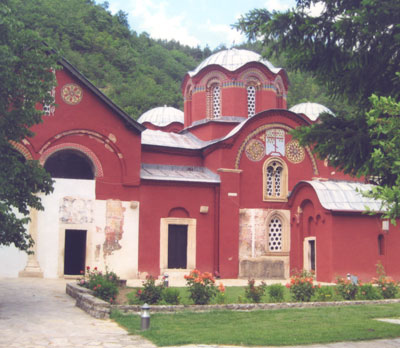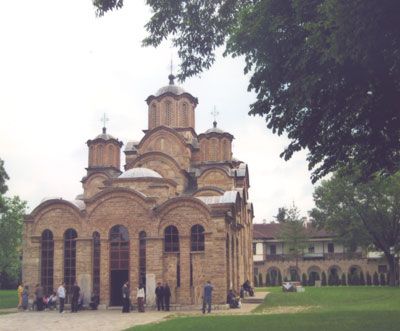Trio of medieval monasteries in Kosovo
This item appears on page 60 of the November 2011 issue.
by Julie Skurdenis (part 2 of 3 on the Balkans)
The small country of Kosovo, in Eastern Europe, has seen its share of turmoil in recent years, especially since the breakup of Yugoslavia that began in the 1990s.
When Serbia emerged from the old Yugoslavia (more accurately, it “reemerged,” since Serbia once existed as an independent kingdom in the Middle Ages), Kosovo was part of this “new” Serbia, a political fact that changed in February 2008 when Kosovo declared its independence. Thus far, that independence has been recognized by more than 75 nations, including the United States, but not by Serbia.
My husband, Paul, and I visited Kosovo in June 2011 as part of a customized private tour arranged by Bestway Tours that also included Serbia, Macedonia and Montenegro. Although we had only two nights in Kosovo, we packed in quite a bit, including a trio of remarkable monasteries that all are UNESCO World Heritage Sites.
Gračanica Monastery
Gračanica Monastery, located three miles from Pristina, Kosovo’s capital, was the first of the three we visited. It’s considered one of the gems of Serbian Orthodox ecclesiastical architecture.
Built in 1321 by King Milutin of the powerful Nemanjic dynasty whose empire stretched across much of the Balkans, Gračanica’s Church of the Assumption is a striking combination, on the outside, of Eastern Byzantine and Western Gothic influences.
The dim interior is packed with 14th-century frescoes, which are difficult to see (no flashlights are allowed). But with patient peering — and the help of a booklet in English sold at the monastery bookshop — it is possible to pick out the Nemanjić family tree as well as the full-length portraits of King Milutin and his wife, Simonida, the daughter of a Byzantine emperor.
These portraits are depicted on the main arch of the entrance, with Milutin holding a model of Gračanica in his hands.
Gračanica, like the other two churches we visited, is under NATO protection, with armed soldiers (Swedes stationed here) outside the main entrance. As we emerged from the church, a procession led by a priest entered the monastic complex, circled the church, then encircled a gigantic oak tree.
Our guide told us the tree was ancient, probably as old as the monastery, itself (700 years), but he couldn’t tell us of the connection between the procession and the oak tree. To us, it seemed primeval, somehow going back in time to pre-Christian roots.
Dečani Monastery
In an idyllic setting of mountains about 50 miles west of Pristina lies Dečani Monastery. Built between 1321 and 1331 by King Stefan Uroç III, the son of King Milutin, Dečani, like the other monastic complexes, is enclosed within walls.
The Church of the Ascension combines Romanesque, Gothic and Byzantine, all three architectural styles blending seamlessly. Especially noteworthy and beautiful are the stone carvings around the windows and doors.
The church’s interior is covered with hundreds of frescoes, serving as an illustrated “book” for medieval illiterates in much the same way that stained glass served that function in Western European church architecture.
In the narthex, the part of the church before one enters the nave or main section of the church, there is another Nemanjić dynasty family tree, with St. Simeon Nemanja and his sons, Sava and Stefan the First-Crowned, at the root of the tree. Stefan, himself, who ruled from 1168 to 1196, rests in a marble tomb in front of the church’s iconostasis.
Dečani, like Gračanica, is protected by NATO soldiers, Italians here. Paul asked them, in Italian, where they were from. “Abruzzo” was the reply. “Oh, my family, too, comes from Abruzzo,” Paul said. “Beautiful place, mountainous like here. I hope you all get home soon.”
Peć Monastery
My favorite of the three monasteries is the Patriarchate of Peć, located in western Kosovo. It’s an area of extraordinary beauty, with Peć Monastery set among mountains and forests.
Pec is the seat of the Serbian Orthodox church — seemingly unusual in a country where 90% of the population is Muslim until one remembers that Kosovo was “part” of Serbia until quite recently.
Surrounded by high walls — and with a NATO checkpoint — Pec Monastery is surrounded by rose gardens and the atmospheric ruins of medieval monastic buildings. It’s these gardens and ruins that make it my favorite monastery.
Peć is unique in having three distinct churches joined by a single narthex, similar to an entry foyer serving all three churches.
The oldest of the three is the Church of the Holy Apostles, built in the 1230s by St. Sava, the first Serbian archbishop. On one side is the Church of St. Demetrius, built about 1321, and on the other, the Church of the Holy Virgin, constructed a few years later.
The narthex has a fresco displaying the Nemanjić family tree, just as at Gračanica and Dečani. The frescoes — again as at the other two monasteries — are incredible, although they’re often difficult to discern in the gloom of the churches’ interiors.
It is the details that I love the most: the Baby Jesus being bathed in a large font; a rooster crowing atop a tilted building as Christ is brought before Pontius Pilate, and Archbishop Danilo II holding a model of his church, the Church of the Holy Virgin.
There is a fourth UNESCO World Heritage Site, the Church of the Holy Virgin of Leviska. We weren’t able to get inside because, we were told, two different keys were needed: one held by the NATO guard on duty and the other by a local priest, who couldn’t be found. We were also told, but couldn’t verify, that the 14th-century frescoes inside were almost totally destroyed during the 2004 riots.
From the outside the church looks forlorn, with barbed wire surrounding it. Perhaps it was just as well we didn’t see the devastation inside. Thank goodness the other three UNESCO monastic sites emerged from troubled times relatively unscathed.
If you go…
Our private, customized tour that included 20 days in Serbia, Macedonia, Kosovo and Montenegro was arranged by Bestway Tours & Safaris (Burnaby, BC, Canada; 800/663-0844 or 604/264-7378), with three decades in the travel business arranging both individual tours as well as group tours to destinations around the world.
Bestway also offers a 20-day group tour, “Balkan Mosaic,” to eight Balkan countries twice a year (in 2012 departing May 26 and Sept. 15). Prices range from $6,070 to $7,875, depending on the number of participants (maximum, 14).


